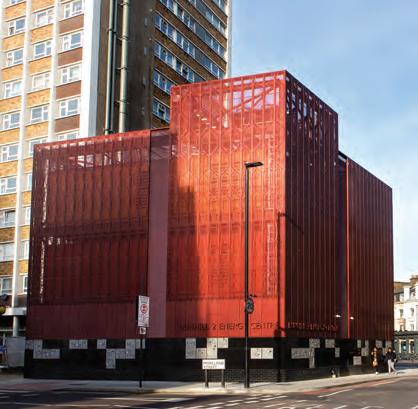
15 minute read
News Update
Project to assess old housing stock
Advertisement
The Scottish Funding Council (SFC) has appointed Professor Ken Gibb, director of the UK Collaborative Centre for Housing Evidence, to lead a 12-month demonstration project evaluating the energy and carbon reduction secured by a high-quality Enerphit retrofit of an eight-property, pre-1919 tenement block in Glasgow. The property had previously been privately rented. The project forms a key part of the SFC’s new Climate Emergency Collaboration Challenge.
Critical to this project will be assessing the scalability and replicability of the lessons learned for Glasgow’s wider pre-1919 tenement stock.
According to Gibb, “The timing of the call is closely related to the climate emergency stance of the Scottish Government but also, of course, the United Nations COP26 conference which is due to take place in Glasgow in November.” The project is aiming to raise the energy efficiency of the property to an EnerPhit standard, a recognised PassivHaus refurbishment standard.
The project will evaluate its replicability and feasibility for other models of older tenements. First, Gibb will undertake an assessment of the building performance, carbon and thermal efficiency changes brought on by the retrofit. Potential energy savings of 75 per cent have already been identified. This will be followed by an assessment of the project from a finance and public policy perspective, focusing on the costs and benefits of the demonstration project.
Then, Gibb will consider the scalability and replicability of the project, linking this to new and emerging models of delivering and funding retrofit of older tenements. Finally will come a major programme of knowledge exchange and dissemination to different landlords, consumers, and policy makers.
Professor Gibb said: “The research project is an ambitious and multi-dimensional, multidisciplinary one. It is an exciting opportunity to work on something that can make a genuine difference.”
REPORTING TOOL FOR UK BUSINESSES Easier route to carbon reporting
A new digital tool will make it easier and more convenient for businesses to comply with energy and carbon reporting rules. Businesses can now digitally report such data in the same way as financial information.
The Streamlined Energy and Carbon Reporting (SECR) taxonomy allows businesses to report their energy and carbon data when they file digital accounts with Companies House.
SECR now covers almost 12,000 UK businesses. The taxonomy has been developed by the Financial Reporting Council (FRC) in collaboration with Companies House and the Department of Business, Energy and Industrial Strategy (BEIS). It enables businesses to report information in XBRL, a format already used by many companies submitting accounts, but this is the first time it has been utilised to capture environmental data in annual reports.
SECR legislation, which came into force on 1 April 2019, requires all
large UK companies and large LLPs, as well as other quoted companies, to report on their annual energy use and greenhouse gas emissions, detailing all energy efficiency actions they have taken. Other businesses can also include the disclosures on a voluntary basis.
Companies House and the FRC are responsible for ensuring businesses comply with the SECR reporting requirements. Director of Digital at Companies House, Ross Maude said: “This is a fantastic example of cross-government working to deliver a digital service that addresses an important issue. Understanding the role businesses have in reducing energy and carbon emissions is central to delivering the UK’s ambition to reach net zero carbon by 2050. Through effective collaboration, we can make it easier for businesses to play their part.”
Project director for taxonomies at the FRC, Jennifer Guest, said: “Enabling companies to file their SECR reports digitally within their annual financial report is an important step in improving transparency of companies’ energy reporting.”
Companies that fail to comply with the new SECR requirements may have to resubmit their annual company accounts to Companies House, or pay fines if missing filing deadlines. Failure to file confirmation statements or accounts is a criminal offence which can result in directors being fined personally in the criminal courts.
Waste heat from Underground to heat homes
Waste heat from the London Underground network is now capable of providing heating and hot water to more than 1,350 homes, a school and two leisure centres in Islington thanks to a recently opened pioneering energy centre.
The Bunhill 2 Energy Centre – the first of its kind in the world – provides a blueprint for decarbonising heat in potential future schemes in London and around the world, reducing heating bills and carbon emissions while improving air quality and making cities more selfsufficient in energy.
The new energy centre uses state-of-the-art technology on the site of the disused City Road underground station that commuters have not seen for almost 100 years.
During the winter months, a fan in the ventilation shaft extracts warm air from the tube which travels over a series of water-filled pipes, heating the water inside by a few degrees. The water temperature is then increased to about 80 o C using heat pumps, which is suitable for domestic and commercial central heating systems. The fan also has the potential to operate in reverse to supply cooler air to the Tube tunnels during the summer months.
The hot water is pumped around a network of insulated underground pipes, and the heat is again transferred to communal heating system loops on housing estates using heat exchangers.
The heating bills for council tenants connected to the network will be cut by 10 per cent compared to other communal heating systems, which themselves cost around half as much as standalone systems heating

individual homes. The nearby Moreland Primary School is the first school to be connected to the network, which already serves the pool and facilities at Ironmonger Row Baths and Finsbury Leisure Centre.
The remains of the station, once known as City Road, have been transformed to house a huge underground fan which extracts warm air from the Northern line tunnels below. The warm air is used to heat water that is then pumped to buildings in the neighbourhood through a new 1.5km network of underground pipes.
Zero-carbon homes ‘in five years’ HOUSING SECRETARY ENDORSES COMMISSION REPORT
“Zero-carbon homes should be built as standard in England within the next five years, as we learn again how our built and natural environments can work in harmony,” Housing Secretary Robert Jenrick has said, as he welcomed the findings of a government-appointed commission into the future of housing.
The Secretary of State’s comments came in response to the Building Better, Building Beautiful Commission’s final report. The Commission’s role has been to focus upon health, well-being and sustainable growth. It has made a series of recommendations for realising the government’s ambition to build 1m new homes by the end of the current Parliament.
The Commission has called for a new ‘fast track for beauty rule’ for local authorities, to ensure speedier planning approval for developers that create proposals for well-designed, more energy-efficient buildings.
They also suggested levying zeroor low-VAT on work to improve the energy performance of existing buildings, and said communities should have greater say over local developments, with planning authorities encouraged to prioritise projects which are future-proofed and enhance adaptability for potential future uses.
“The greenest building is one that is already built,” the report states, joining the chorus of campaigners urging the government to come forward with more ambitious plans to support green upgrades to the current building stock.
Jenrick welcomed the Commission’s findings, to which the government plans to issue a full

response “ in due course”, and stressed that “beautiful, high-quality homes must become the norm, not the exception”.
He also signalled his interest in the Commission’s recommendations for implementing a ‘fast track for beauty’ standard, and building net zero homes.
“I want to see zero carbon homes being built as standard within five years as we learn again how our built and natural environments can work in harmony,” he said.
The built environment currently accounts for around 40 per cent of the UK’s greenhouse gas emissions. The government has promised to introduce a Future Homes Standard that would ensure all new homes are built without fossil fuel heating from 2025. Initial improvements to parts L and F of the building regulations will be issued in December. However, Ministers are facing criticism for failing to mobilise increased investment in energy efficiency upgrade programmes for existing homes.
Biomethane to be used to heat Heathrow
ENGIE has signed an agreement with Heathrow Airport to replace natural gas with 100 per cent green biomethane from anaerobic digestion to all meter points, across all terminals until March 2022. This agreement builds on an existing partnership where ENGIE has been supplying biomethane to Heathrow’s Energy Centre, as well as natural gas to other areas.
The biomethane is certified under the Renewable Gas Guarantees of Origin (RGGOs) Scheme as being wholly derived from anaerobic digestion. The agreement represents the largest forward green gas contract ever signed by ENGIE. In addition, Heathrow Airport has the option to purchase more green gas if their requirements exceed the estimated consumption over the contract period.
The biomethane will be injected into the grid by a number of producers using a variety of different feedstocks – all within the UK – delivering a number of benefits to Heathrow and the wider environment. These include reduced carbon emissions compared to natural gas, support for local biomethane production sites and support for wildlife at these sites.
In addition, as the gas is produced in the UK, this supports UK energy resilience with accredited and traceable guarantees of origin and reduces Heathrow’s reliance on traditional routes for energy sourcing.
Matt Gorman, Heathrow’s director

of sustainability, said: “The UK aviation industry has made a firm commitment to get to net zero by 2050, at the very latest. On our journey to rapidly decarbonise every aspect of the industry, we are proud to be partnering with ENGIE to significantly remove carbon from our gas supply, a move that has also helped us to gain carbon neutral status. We urge other companies to join us in making the switch.”
IN BRIEF
Huge need for chargers by 2035
Up to 40,000 chargers would need to be installed per month between now and 2035 for every motorist without private parking to have access to a dedicated charger, according to a new report from EV charging company Connected Kerb. However, the report states that a more realistic measure would be one charger for every four of these motorists, requiring 10,000 chargers to be installed per month within that time frame.
This is dramatically contrasted by the number of EV chargers installed at the end of 2019, which Connected Kerb said was standing at 19,000.
EV charging network sold
Vattenfall has continued refocusing its business in the UK, with the sale of its electric vehicle (EV) charging network to Statkraft.
The move follows the company’s announcement that it was selling its supply side business, iSupply Energy, to EDF. It is looking to invest in developing its core UK businesses: renewable power generation, heating, B2B sales and distribution, said the company.
The Building Controls Industry Association (BCIA) has announced Terry Sharp as its new President. Sharp takes over from Jon Belfield who has held the role for the past two years.
Sharp has worked in the controls industry for over 35 years and is an associate at NDA Consulting, the specialist BEMS and energy consultancy practice. His previous experience includes UK and European leadership roles at Johnson Controls, Sontay and Satchwell Control Systems. After re-joining the BCIA management committee in 2017 Sharp was appointed vice-president of the BCIA in January 2019. New president for controls body
UK’s carbon footprint falls 21% The UK’s total carbon footprint - used to cover consumption-related emissions wherever in the world they occur - fell by 21 per cent between 2007 and 2017, new Government data has revealed.
In order for GHG emissions to be classed as consumption-related, they must be either directly attributable to UK households; generated by the value chain of UK-produced goods and services used by UK residents; or embedded in the value chain of imported goods and services that were ultimately used in the UK.
The data reveals that the national carbon footprint stood at 772m tonnes of CO2e in 2017, down 21 per cent from the 2007 peak of 977m tonnes and down 9 per cent from 1997, when the current series of records began.
Defra analysts broadly attribute this trend to the decarbonisation of energy used to manufacture products; the ongoing shift to service-based models; and efficiency improvements.
On a shorter-term basis, the report also documents a 3 per cent year-on-year reduction in the UK’s carbon footprint from 2016 to 2017. According to Defra, this is in line with the year-on-year trends throughout the rest of the decade and is largely the result in reduced domestic travel, and of the use of renewable electricity by UK manufacturers.
As well as providing a broad overview, the report breaks down trends in emissions from each of the three sources classed as consumption-related.
Emissions generated by the value chain of UK-produced goods and services used by UK residents fell by almost one-third (31 per cent) between 1997 and 2017, as businesses invested in energy efficiency, resource efficiency and renewable energy.
But emissions directly attributable to UK housing stagnated. Every year since 1997, they have stood at between 140 and 160m tonnes of CO2e. While the UK’s housing stock has grown over this 20-year period, green groups including the Government’s own Committee on Climate Change (CCC) have repeatedly pointed out that policy action surrounding energy efficiency and low-carbon heat for homes has not been ambitious enough to meet key climate targets.
US bill would cut energy bills by $51bn BILL RECEIVES BIPARTISAN SUPPORT
A pending bipartisan energy efficiency bill would over time cut carbon dioxide emissions by an amount equal to removing all cars and light trucks from US roads for a year, according to analysis presented to the US Congress by the American Council for an Energy-Efficient Economy (ACEEE).
The Energy Savings and Industrial Competitiveness Act would cut energy bills by $51bn, save 32 quadrillion BTU of energy, and avoid 1.3bn tons of carbon dioxide emissions cumulatively for measures by 2050.
The bill was approved by the Senate Energy and Natural Resources Committee with bipartisan support. Chairman Lisa Murkowski (above) has confirmed she is preparing a package of energy-related bills that have advanced through her committee for a full Senate vote. The bill, introduced in an updated form last year, is supported by a host of business associations and energy efficiency leaders.
The analysis shows that the bill’s provisions on building energy regulations would have by far the largest energy-saving impact.

These provisions would direct the Department of Energy to work with states, Indian tribes, local governments, code and standards developers, and others through a rule making process to develop energy savings targets for model building energy codes. The Department would also assist state adoption of these codes and implement a new grant programme to help homebuilders, contractors, trades, code officials and others to cost-effectively implement updated codes. States and localities would continue to decide which codes to adopt.
“ This would be the biggest cut of energy waste from any new federal law in a decade,” said ACEEE senior policy advisor, Lowell Ungar.
Sustainable offices ‘can offer higher rents’
The latest research from Jones Lang LaSalle has revealed the tangible financial benefits that sustainable office buildings can deliver to investors through a combination of higher rents and stronger leasing velocity. The report, The impact of sustainability on value, also demonstrates the growing occupier demand for sustainable offices in central London that will need to be met in the next decade.
JLL has looked forward to the next wave of office development and the strong impetus for it to deliver net zero carbon buildings. On this basis, JLL has calculated that the next wave of office development and major refurbishment will need to accommodate at least 744,000m2

of highly sustainable demand from occupiers across central London by 2030.
This demand assessment for central London office stock is based on the space currently occupied by companies which have signed up to science based targets (1.11m/ m2) who have lease events before 2030, clearly demonstrating the increasing demand and need for highly sustainable buildings within central London.
The research also identified demand from companies signing up to net zero carbon commitments, who currently occupy over 140,000m2 of space across central London.
JLL’s research found that, based on historical leasing activity, the future development and redevelopment pipeline of offices incorporating sustainability would deliver tangible financial benefits for developers in addition to strong levels of demand.
ECO measures increase, but still way below peak
Figures from the Department for Business, Energy and Industrial Strategy (BEIS) show nearly 220,000 energy efficiency measures were installed through the Energy Company Obligation (ECO) and the Green Deal framework in 2019 - a 5 per cent year-on-year increase.
However, installations remain well below the peak of nearly 800,000 in 2014. As of December, around 2.8m measures had been installed in 2.1m properties, mostly through ECO.
For its third phase beginning in 2018, ECO was refocused on tackling fuel poverty, meaning all of the 221,800 measures installed last year were delivered through the Affordable Warmth strand of the scheme. Installations were concentrated towards the North West and North East, central Scotland and parts of the West Midlands and Wales.
By the end of the year, BEIS said 70 per cent of properties with a cavity wall (14.1m) had cavity wall insulation, two-thirds of those with a loft (16.4m) had the relevant insulation and so did 9 per cent of those with solid walls (764,000).
There was a sharp rise in the number of new boilers being fitted under ECO. They accounted for 30 per cent of installations during the year – up from 16 per cent in 2018.
Cavity wall insulation, which was previously the most common measure, saw its share of installations drop from 38 per cent to 19 per cent. The second most common – solid wall insulation – fell from 19 per cent to 12 per cent.







